Pentium 4 3.46 Extreme Edition and 925XE: 1066MHz FSB Support is Here
by Anand Lal Shimpi on October 31, 2004 3:00 PM EST- Posted in
- CPUs
Workstation Applications
Visual Studio 6
Carried over from our previous CPU reviews, we continue to use Visual Studio 6 for a quick compile test. We are still using the Quake 3 source code as our test and measure compile time in seconds. The results are pretty much in line with what we've seen in the past.
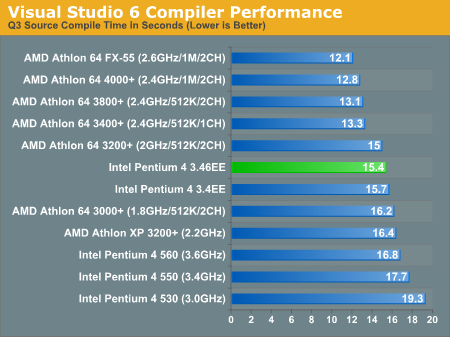
SPECviewperf 8
For our next set of professional application benchmarks we turn to SPECviewperf 8. SPECviewperf is a collection of application traces taken from some of the most popular professional applications, and compiled together in a single set of benchmarks used to estimate performance in the various applications the benchmark is used to model. With version 8, SPEC has significantly improved the quality of the benchmark, making it even more of a real world indicator of performance.
We have included SPEC's official description of each one of the 8 tests in the suite.
3dsmax Viewset (3dsmax-03)
"The 3dsmax-03 viewset was created from traces of the graphics workload generated by 3ds max 3.1. To insure a common comparison point, the OpenGL plug-in driver from Discreet was used during tracing.
The models for this viewset came from the SPECapc 3ds max 3.1 benchmark. Each model was measured with two different lighting models to reflect a range of potential 3ds max users. The high-complexity model uses five to seven positional lights as defined by the SPECapc benchmark and reflects how a high-end user would work with 3ds max. The medium-complexity lighting models uses two positional lights, a more common lighting environment.
The viewset is based on a trace of the running application and includes all the state changes found during normal 3ds max operation. Immediate-mode OpenGL calls are used to transfer data to the graphics subsystem."
The biggest surprise here is that there is a huge performance impact (13%) by moving down to a single channel memory subsystem with the Athlon 64. There are also a couple of other surprises, with the Pentium 4 560 doing surprisingly well, coming in at the heels of the Athlon 64 FX-55.
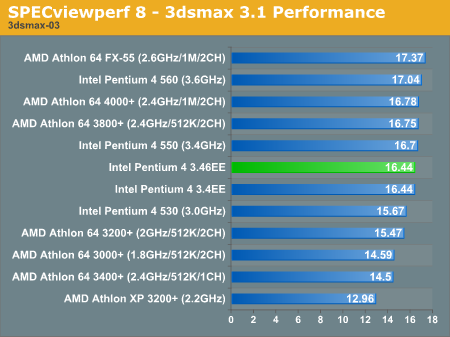
CATIA Viewset (catia-01)
"The catia-01 viewset was created from traces of the graphics workload generated by the CATIATM V5R12 application from Dassault Systems.
Three models are measured using various modes in CATIA. Phil Harris of LionHeart Solutions, developer of CATBench2003, supplied SPEC/GPC with the models used to measure the CATIA application. The models are courtesy of CATBench2003 and CATIA Community.The car model contains more than two million points. SPECviewperf replicates the geometry represented by the smaller engine block and submarine models to increase complexity and decrease frame rates. After replication, these models contain 1.2 million vertices (engine block) and 1.8 million vertices (submarine).
State changes as made by the application are included throughout the rendering of the model, including matrix, material, light and line-stipple changes. All state changes are derived from a trace of the running application. The state changes put considerably more stress on graphics subsystems than the simple geometry dumps found in older SPECviewperf viewsets.
Mirroring the application, draw arrays are used for some tests and immediate mode used for others."

Lightscape Viewset (light-07)
"The light-07 viewset was created from traces of the graphics workload generated by the Lightscape Visualization System from Discreet Logic. Lightscape combines proprietary radiosity algorithms with a physically based lighting interface.
The most significant feature of Lightscape is its ability to accurately simulate global illumination effects by precalculating the diffuse energy distribution in an environment and storing the lighting distribution as part of the 3D model. The resulting lighting "mesh" can then be rapidly displayed."

Maya Viewset (maya-01)
"The maya-01 viewset was created from traces of the graphics workload generated by the Maya V5 application from Alias.
The models used in the tests were contributed by artists at NVIDIA. Various modes in the Maya application are measured.
State changes as made by the application are included throughout the rendering of the model, including matrix, material, light and line-stipple changes. All state changes are derived from a trace of the running application. The state changes put considerably more stress on graphics subsystems than the simple geometry dumps found in older viewsets.
As in the Maya V5 application, array element is used to transfer data through the OpenGL API."
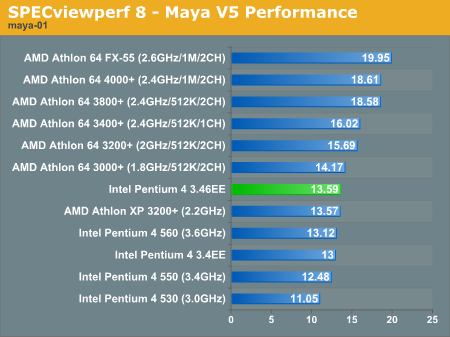
Pro/ENGINEER (proe-03)
"The proe-03 viewset was created from traces of the graphics workload generated by the Pro/ENGINEER 2001TM application from PTC.
Two models and three rendering modes are measured during the test. PTC contributed the models to SPEC for use in measurement of the Pro/ENGINEER application. The first of the models, the PTC World Car, represents a large-model workload composed of 3.9 to 5.9 million vertices. This model is measured in shaded, hidden-line removal, and wireframe modes. The wireframe workloads are measured both in normal and antialiased mode. The second model is a copier. It is a medium-sized model made up of 485,000 to 1.6 million vertices. Shaded and hidden-line-removal modes were measured for this model.
This viewset includes state changes as made by the application throughout the rendering of the model, including matrix, material, light and line-stipple changes. The PTC World Car shaded frames include more than 100MB of state and vertex information per frame. All state changes are derived from a trace of the running application. The state changes put considerably more stress on graphics subsystems than the simple geometry dumps found in older viewsets.
Mirroring the application, draw arrays are used for the shaded tests and immediate mode is used for the wireframe. The gradient background used by the Pro/E application is also included to better model the application workload."
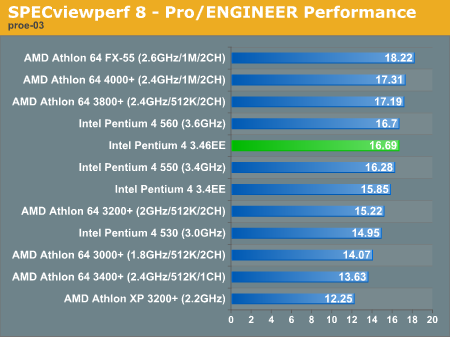
SolidWorks Viewset (sw-01)
"The sw-01 viewset was created from traces of the graphics workload generated by the Solidworks 2004 application from Dassault Systemes.
The model and workloads used were contributed by Solidworks as part of the SPECapc for SolidWorks 2004 benchmark.
State changes as made by the application are included throughout the rendering of the model, including matrix, material, light and line-stipple changes. All state changes are derived from a trace of the running application. The state changes put considerably more stress on graphics subsystems than the simple geometry dumps found in older viewsets.
Mirroring the application, draw arrays are used for some tests and immediate mode used for others."
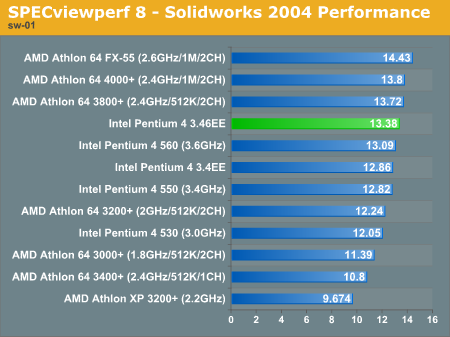
Unigraphics (ugs-04)
"The ugs-04 viewset was created from traces of the graphics workload generated by Unigraphics V17.
The engine model used was taken from the SPECapc for Unigraphics V17 application benchmark. Three rendering modes are measured -- shaded, shaded with transparency, and wireframe. The wireframe workloads are measured both in normal and anti-alised mode. All tests are repeated twice, rotating once in the center of the screen and then moving about the frame to measure clipping performance.
The viewset is based on a trace of the running application and includes all the state changes found during normal Unigraphics operation. As with the application, OpenGL display lists are used to transfer data to the graphics subsystem. Thousands of display lists of varying sizes go into generating each frame of the model.
To increase model size and complexity, SPECviewperf 8.0 replicates the model two times more than the previous ugs-03 test."











63 Comments
View All Comments
Beenthere - Sunday, October 31, 2004 - link
Intel has simply run out of Hail Mary solutions to their unending design, engineering, production, sales, management, and marketing problems. Even Wall Street knows this by now.Wesley Fink - Sunday, October 31, 2004 - link
For those who asked, the 1000 lot Intel price for the 3.46EE is $999.coldpower27 - Sunday, October 31, 2004 - link
Well you could get a direct comparison between the Athlon 64 3700+ vs the Pentium 4 560 as those 2 processors are priced pretty directly against each other on Newegg, though their MSRP differ in actuality.64Bit Windows isn't likely to be released until Prescott 2M with Intel EM64T is released in Q1 2005. We will have to see though if Microsoft will released in 2005 WinXP 64.
jimmy43 - Sunday, October 31, 2004 - link
#14 I was thinking the same thing. The 3500 would probably still win or tie in most of the categories and it costs nearly half the price of an intel 560. I feel like Anand is trying to be fair to both companies and reccomending a bit of both. Realistically, AMD has Intel beat in every market segment... by alot. It's also funny how everyone is COMPLETELY forgetting that AMD's proccessors are 64 bit so in a year or so, you will get a considerable free speed boost and youl be able to run the latest OS. Is that not a huge advantage? Come on, people need to stop overlooking that its really bugging me.DukeN - Sunday, October 31, 2004 - link
Once again, Intel shows why it's the Sony of the CPU world with terrible products terribly overpriced.Gnoad - Sunday, October 31, 2004 - link
I might have missed it, but how much will Intel price this at? Considering it's an EE, one can guess about $900. If thats true, they MIGHT sell 3 or 4 of them.skunkbuster - Sunday, October 31, 2004 - link
underdog in terms of market shareGhandiInstinct - Sunday, October 31, 2004 - link
Since when did the world spin where a chip that is superior in 90% of chip tasks is the underdog?stephenbrooks - Sunday, October 31, 2004 - link
So... I was thinking of investing some money in shares. You don't think AMD might happen to be a good bet right around now, would you?SLIM - Sunday, October 31, 2004 - link
Great review as always, but there's always room for improvement:)[/begin nitpicking]
"So in the end, who takes the crown? AMD or Intel? The 3800+ took four category wins, while the Pentium 4 560 only took two, however with the exception of the gaming and professional apps category, AMD's victories were not overwhelming - especially once you take into account the fact that the 3800+ is priced much higher than the Pentium 4 560. Now that you can purchase at least a couple of 915 based motherboards for less than $130 the total cost of ownership for the Intel platform doesn't eat into the CPU price advantage. For the most part we'd say the 3800+ is faster than the Pentium 4 560 but not always worth the added cost. It's unusual but in many cases, the Pentium 4 560 is actually the bargain high-end chip of the two."
Alrighty, two comments:
1) It's bad science to make a detailed comparison, and then in the conclusion talk about switching the chipset and memory in order to make the price comparison hold up. (Maybe include the numbers from a 915 review to back up the assertion that the 560 will still perform just as well with 915/DDR).
2) I'd be curious to see how the 3500+ would hold up in these same comparisons since it is about $150 cheaper than the 560.
Bonus nitpick:
4 of the graphs don't include the new 3.46ee (ACD on page 9 and 3 games benches); I don't know if that was intentional or not. [/end nitpicking]
Thanks again for the best reviews.